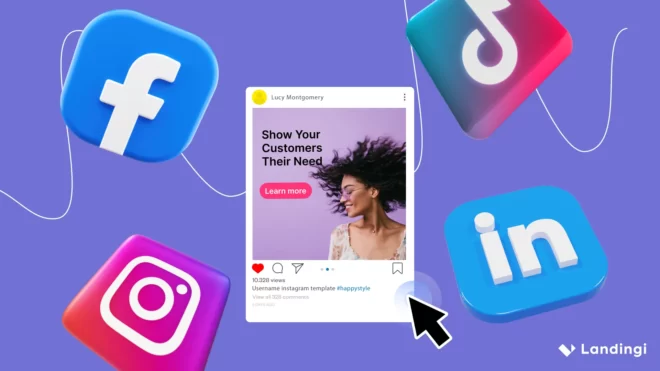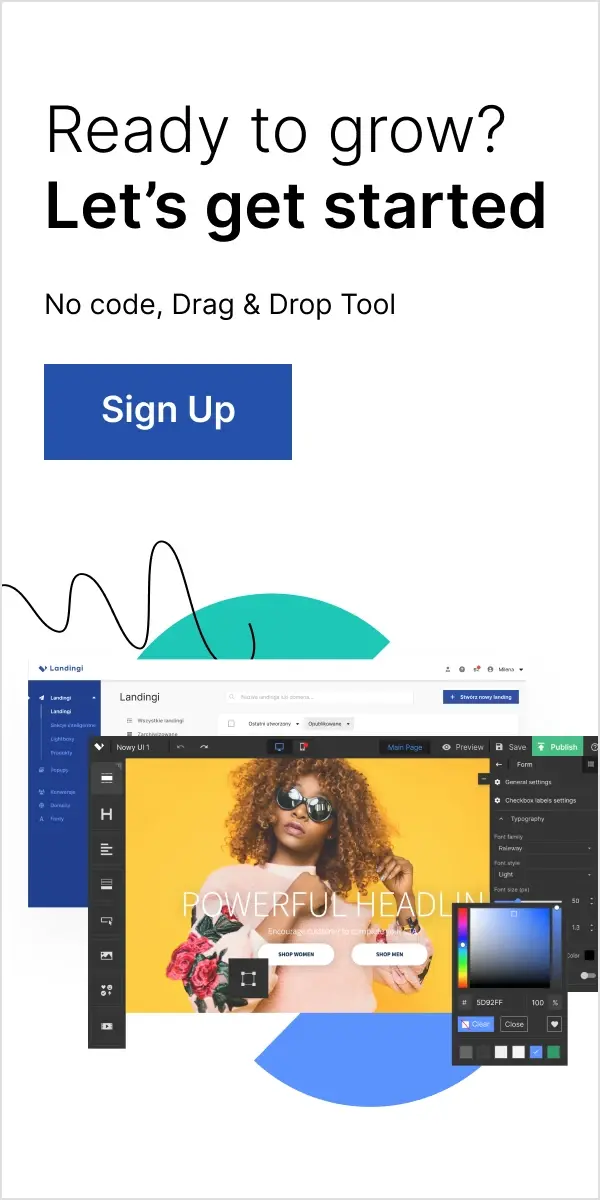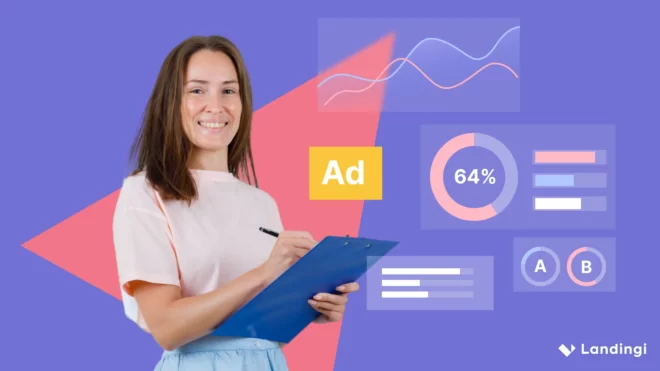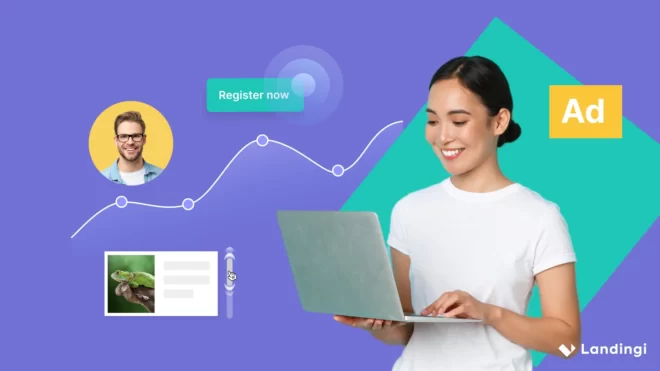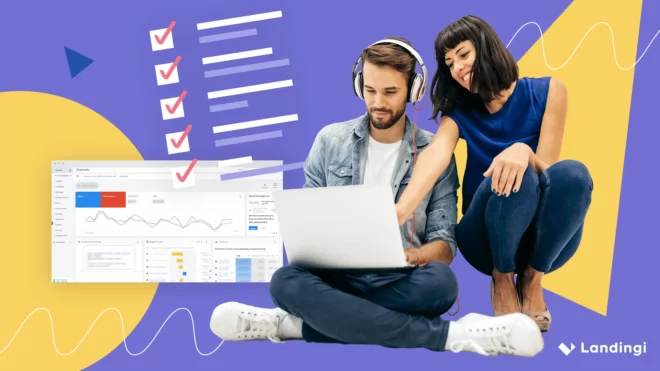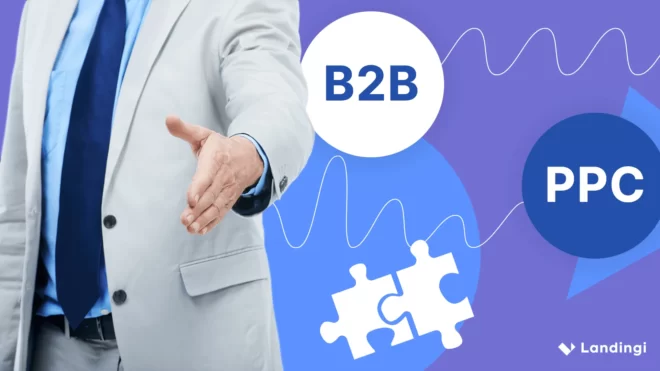PPC social media advertising involves placing ads on popular platforms like Facebook, Instagram, or YouTube, where advertisers pay a fee for clicks or impressions. This advertising model is great for businesses of all sizes in every industry. Imagine the power of reaching the right people at the right time with the right message – that’s the magic of PPC in social media. Such ads allow users to easily find offers that answer their needs and interests. At the same, SM advertising has become a foundation of digital marketing strategies, allowing businesses to reach their target audiences effectively.
Ca. 89% of marketers leverage Facebook for business purposes, while 80% make use of Instagram, as mentioned in one of the newest Social Champ articles. It underscores the power of SM PPC meaning in brand building. When comparing this information with data saying 61% of the world population uses social media daily, it becomes obvious how profitable can be leveraging SM ads in digital marketing campaigns.
You must know that a stunning video ad with compelling content is not enough to succeed – a crucial component of any PPC campaign is the landing page, where conversions occur. You should complete your ad using professional tools like Landingi, the best PPC marketing tool for creating effective landing pages that match your social media ads. Social media ads require a different approach than usual PPC strategies – this article will delve into the complexities of PPC social media advertising, outline its costs, and provide real-world examples to illustrate successful campaigns.
For a good start, take a look at the 5 best practices for effective social media PPC campaigns:
- Understand your audience to leverage the full potential of social media ad targeting.
- Use stunning videos and high-quality images to attract users.
- Keep a consistent style across all marketing channels to build brand awareness efficiently.
- Remember about well-optimized landing pages to drive higher conversion.
- Utilize retargeting to generate more leads.
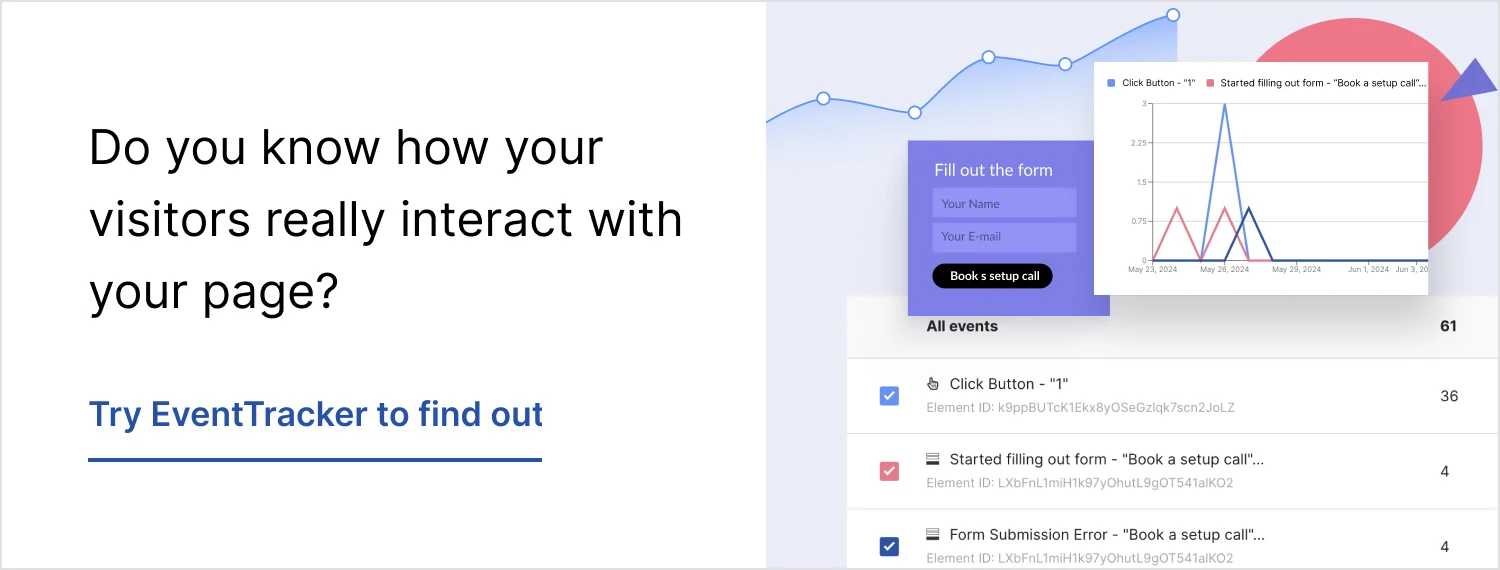
What is PPC in Social Media?
PPC in social media platforms is a dynamic and strategic form of online advertising where advertisers pay a fee for clicks (CPC) or impressions (CPI). This model is a game-changer across popular platforms like Facebook, Instagram, LinkedIn, YouTube, and others, offering businesses a golden opportunity to showcase their content, products, or services to a highly targeted audience.
PPC campaigns in social media are designed to leverage the extensive user data these platforms collect, including their professions, hobbies, and other information classical PPC ads can’t involve. Advertisers can fine-tune their campaigns to target users based on demographics, interests, behaviors, and even specific interactions with the platform. For instance, if you are selling fitness products, you can create a PPC ad campaign targeting users who have shown an interest in fitness-related content. Precise targeting ensures that your ad dollars are spent wisely, reaching those most likely to convert.
The success of a PPC campaign in social media is often measured by key performance indicators (KPIs) such as click-through rates (CTR), conversion rates, cost per click (CPC) or per impressions (CPI), and return on ad spend (ROAS). This data provides valuable insight into the effectiveness of a campaign, enabling it to optimize and better meet user expectations. You can continuously monitor and optimize your campaigns, making real-time adjustments to maximize ROI. The data-driven approach allows for smart budgeting and strategic planning, transforming PPC into a powerful tool for driving growth and achieving marketing objectives.
How Does Social Media PPC Advertising Work?
Social media PPC advertising relies on two pillars: targeting the audience and optimizing the campaign. Once you know your goal and have identified your perfect potential customers, you have to choose the social media platforms for your campaign and define your target audience groups. The campaign based on visuals and compelling copy should direct users to the specific landing page, designed to convert. The rest is regular monitoring and continuous optimization, also through A/B tests, enabling you to achieve the best results.
Check out the detailed description of the SM PPC advertising process in 9 steps below:
1. Defining campaign objectives
Clear objectives are essential for any PPC campaign. Goals can range from increasing brand awareness and driving website traffic to generating leads and boosting sales. Defining these objectives helps shape the entire campaign strategy, including ad creation and targeting.
2. Choosing the right platform
Your advertisement channels should be chosen from the most popular social media platforms like Facebook, Instagram, Twitter, LinkedIn, or YouTube. Each platform offers unique targeting options and ad formats, so it’s important to choose based on where your target audience is most active.
3. Targeting the audience
One of the biggest advantages of social PPC advertising is the ability to target audiences with laser precision. You can define your audience based on various criteria such as age, gender, location, interests, behaviors, and even specific interactions with content on the platform. This ensures that ads are shown to users most likely interested in the offer.
4. Creating compelling ads
Ad creation involves designing eye-catching visuals and writing engaging copy. The ads need to be compelling and relevant to the target audience. Including a strong CTA is crucial to encourage users to click on the ad. Ad formats can vary from image and video ads to carousel and slideshow ads, depending on the platform.
5. Optimizing landing page
The ad can be perfectly designed but means nothing when not linked to a well-optimized landing page. Once the user clicks the ad, it should direct him to the specific page focused on a single purpose, consistent with the ad. The PPC landing page should have a clear layout without extensive navigation, a strong and visible CTA button, persuasive content, and, if needed, a simple form. The page must be mobile-friendly to ensure a seamless experience for social media users.
6. Setting up budget
Social PPC advertising operates on a bidding system. You set a budget for your campaign and decide on a bidding strategy, such as cost-per-click (CPC) or cost-per-impression (CPM), depending on your chosen platform. The bid amount influences the ad’s placement and competitiveness. Higher bids can lead to better ad placement, but it’s important to balance amounts with the campaign budget.
7. Launching the campaign
Once everything is set up, the campaign goes live. Ads are displayed to the targeted audience based on the criteria and budget. You pay each time a user clicks on the ad (CPC) or for every thousand impressions (CPM).
8. Monitoring and Optimization
Continuous monitoring is key to a successful social PPC campaign. You should track performance metrics such as click-through rates (CTR), conversion rates, and cost per click (CPC). Based on these insights, you can make real-time adjustments to bids, targeting, and ad creatives to optimize performance and achieve better results.
9. Analyzing Results
At the end of the campaign, a thorough analysis helps evaluate its success against the initial goals. This analysis includes reviewing metrics like engagement rates, conversions, and return on ad spend (ROAS). These insights are invaluable for refining future campaigns and improving overall PPC strategy.
5 PPC Social Media Best Practices
Meet the 5 PPC social media best practices that will let you drive more clicks, likes, shares, and, most importantly, more conversions. Make your SM ads better with a handful of proven tips, as follows:
#1 Know your audience
Understanding your target audience is crucial for the success of your social media PPC campaigns – scrolling social media is their daily hobby, so you have to know how to adjust your offer to their interests. Use the advanced targeting options available on social media platforms to define your audience based on demographics, interests, behaviors, and past interactions. Depending on the platform and your ad goals, focus on basic factors as follows:
- age range,
- gender,
- profession,
- hobbies and interests,
- specific content interactions,
- localization,
and more, making your ad perfectly tailored to the image of a perfect potential customer. Social media allow for precise targeting, making it one of the most beneficial ad channels. Once you have correctly identified your target audience, you can be sure your offer will be tailored to resonate with these segments, ensuring relevance and higher engagement rates.
#2 Create compelling ad creatives
High-quality visuals and engaging ad copy are vital to capturing your audience’s attention. Use eye-catching images or videos and craft compelling headlines and descriptions that align with your audience’s interests and needs. If you decide to use video content, stick to a few tips, as follows:
- Keep it short, considering short attention spans and social media characteristics.
- Keep it natural, the proper quality can be achieved even with a phone camera and a good light.
- Leave the bottom section without text.
- Use closed caption (CC), enabling users to understand your ad message without sound.
Incorporate strong CTAs to encourage clicks and conversions. A/B testing different creatives can help identify what resonates best with your audience.
#3 Use your brand style
Consistency is key to building brand recognition and trust. Ensure your ads reflect your brand’s unique style, including colors, fonts, and overall design. Visual uniformity reinforces brand identity and helps create a cohesive and professional look across all your marketing materials. By maintaining consistent branding, you ensure that your audience immediately recognizes your brand, which builds familiarity and trust. This approach enhances the effectiveness of your campaigns, as a unified brand presence makes your ads more memorable and impactful, ultimately driving better engagement and conversion rates.
#4 Create and optimize a landing page
The landing page is essential to any advertising, allowing you to generate leads and increase sales. Ensure that the landing pages your ads link to are relevant, fast-loading, and optimized for conversions. The user experience should be seamless from ad click to conversion, with clear CTAs and minimal distractions. Use professional tools, like Landingi, to design a high-converting landing page for your ad. Its user-friendly, AI-powered builder will help you craft a page that guides users through compelling content to the desired action.
Leverage its A/B testing feature to experiment with various page versions and use EventTracker to track user behavior. Make data-based changes and optimize your landing page for higher conversion. With Landingi, building, testing, and optimizing landing pages goes effortlessly, even for those without advanced skills and professional knowledge.
#5 Utilize retargeting
Retargeting can significantly improve conversion rates by reaching out to users familiar with your offerings, enhancing brand recall and encouraging them to complete their purchase. Implement retargeting campaigns to re-engage users who have interacted with your brand but haven’t converted. This strategy allows you to display targeted ads to these users as they browse other sites or social media, reminding them of your products or services. By staying in their minds, you increase the likelihood of converting previous visitors into loyal customers, ultimately increasing your overall ROI.
How to Start a PPC Campaign on Social Media?
To start a PPC campaign on social media, begin by selecting the appropriate platform, such as Facebook, Instagram, or YouTube, based on where your target audience is most active. You can use publicly available data on social media usage broken down by specific factors, such as age, gender, etc., to find the best ad channel for your objectives. Take a look at the data from the Pew Research Center survey on the U.S. adults using social media per age (2023):
- For users at the age of 18-29, the most popular social media platforms are YouTube (93%), Instagram (78%) and Facebook (67%).
- For users between the ages of 30 and 49, the most popular social media platforms are YouTube (92%), Facebook (75%), and Instagram (59%).
- For users at the age of 50-64, the most popular social media platforms are YouTube (83%), Facebook (69%) and Instagram (35%).
- For users aged 64 and older, the most popular social media platforms are YouTube (60%), Facebook (58%), and Pinterest (21%).
Such data make it easier to find the best social media platform for your ads, depending on your campaign objectives and specified target audiences.
Once you have chosen the right platform, define clear objectives for your campaign, whether it’s increasing brand awareness, driving traffic, generating leads, or boosting sales. Then, as you understand your target audience groups, use the platform’s advanced targeting options to pinpoint demographics, interests, and behaviors.
After these steps, when you have prepared ad creatives and linked your PPC landing page, set a budget that aligns with your goals and choose a bidding strategy that suits your objectives: cost-per-click (CPC) for traffic or cost-per-impression (CPI) for brand awareness.
Launch your campaign and monitor its performance closely using the platform’s analytics tools. Track KPIs and use these insights to make data-driven adjustments, optimizing your targeting, ad creatives, and bids to improve performance continuously. By staying proactive and adaptive, you can maximize the effectiveness of your PPC campaign on social media, driving better results and achieving your marketing goals.
What Is the Cost of a PPC Social Media Campaign?
The cost of a PPC social media campaign starts from avg. $0.0–$0.25 (CPC Instagram) to avg. $2–$3 (CPC LinkedIn), depending on the chosen platform, industry, campaign goals, and geographical localization. PPC Costs can be assumed in advance, as you can set your budget at the ad creation level. The average costs of PPC social media campaigns on various platforms in 2024, according to WebFX statistics, are the following:
1. Facebook
- Avg. CPC (cost per click): from $0.26 to $0.50
- Avg. CPM (cost per 1000 impressions): from $1.01 to $3.0
2. Instagram
- Avg. CPC (cost per click): from $0.0 to $0.25
- Avg. CPM (cost per 1000 impressions): from $0.0 to $4.0
3. YouTube
- Avg. CPV (cost per view): from $0.31 to $0.40
4. LinkedIn
- Avg. CPC (cost per click): from $2.0 to $3.0
- Avg. CPM (cost per 1000 impressions): from $5.01 to $8.0
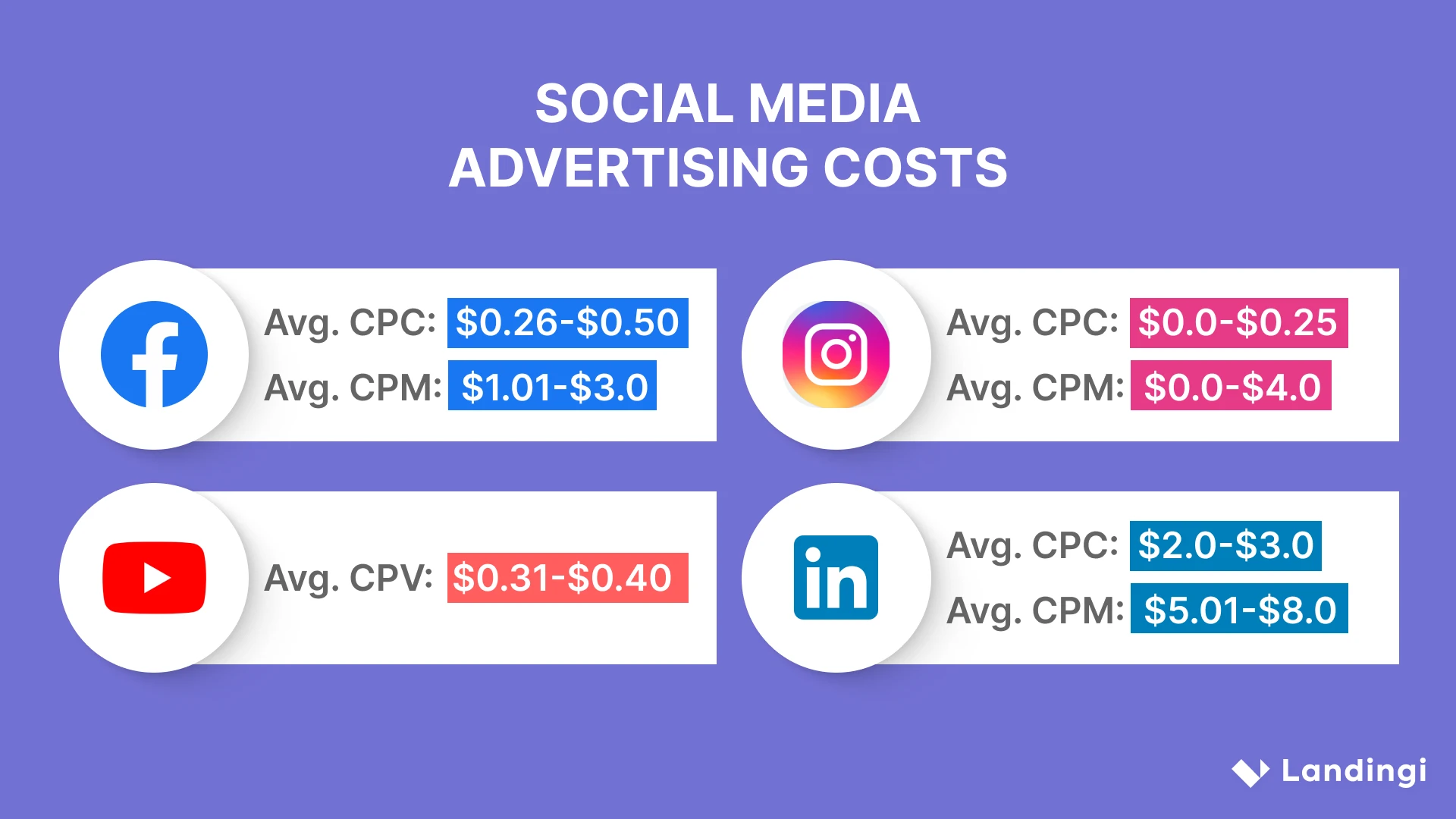
Factors affecting the cost of social media PPC advertising involve the following:
- Campaign objectives – different goals (e.g., brand awareness, lead generation, conversions) have varying costs. Conversion-focused campaigns tend to be more expensive due to higher competition.
- Industry and competition – highly competitive industries such as finance or insurance often see higher CPCs.
- Ad placement and structure – premium ad placements and advanced targeting options increase costs.
- Geographical location – advertising in regions with high internet penetration and competitive markets typically incurs higher costs.
If you consider hiring professionals to manage your social media PPC campaigns, you will pay between $500 and $2000 per month on average for PPC management by freelancers. Hiring a PPC management agency can range from $1500 to $25,000 per month, depending on the scope and scale of services offered.
3 Examples of PPC Social Media Advertising
Check the real-life PPC social media advertising examples and inspire yourself on how to prepare your own campaigns. Each example showcases a different ad format, from static image ads to immersive video-based ones.
1. Lingopie
The first example illustrates a video ad on YouTube, which appears either before the desired video starts (pre-roll), during the video (mid-roll), or after it ends (post-roll), ensuring it captures the viewer’s attention at strategic moments. Lingopie uses an explainer video showcasing product features and highlighting its benefits. It’s an effective way to catch users’ attention and show new opportunities related to their hobbies or interests.
YouTube’s targeting options allow advertisers like Lingopie to reach specific demographics, interests, and behaviors, ensuring that the ad is shown to users most likely to be interested in language learning. This precise targeting, combined with the engaging nature of video content, makes YouTube ads highly effective for capturing user attention and driving conversions. By aligning the ad content with the viewers’ hobbies or interests, Lingopie can create a strong connection with potential customers, showcasing new opportunities and motivating them to explore the product further.
The ad includes a strong CTA, directing users to the landing page focused on a single goal – registering for a free trial. This way, the ad is effective: a clear page layout, compelling headlines, additional information, and an outstanding, well-placed CTA button make this landing page a powerful lead-generation tool. The consistency between an ad and the landing page is crucial, ensuring users are in the right digital space.
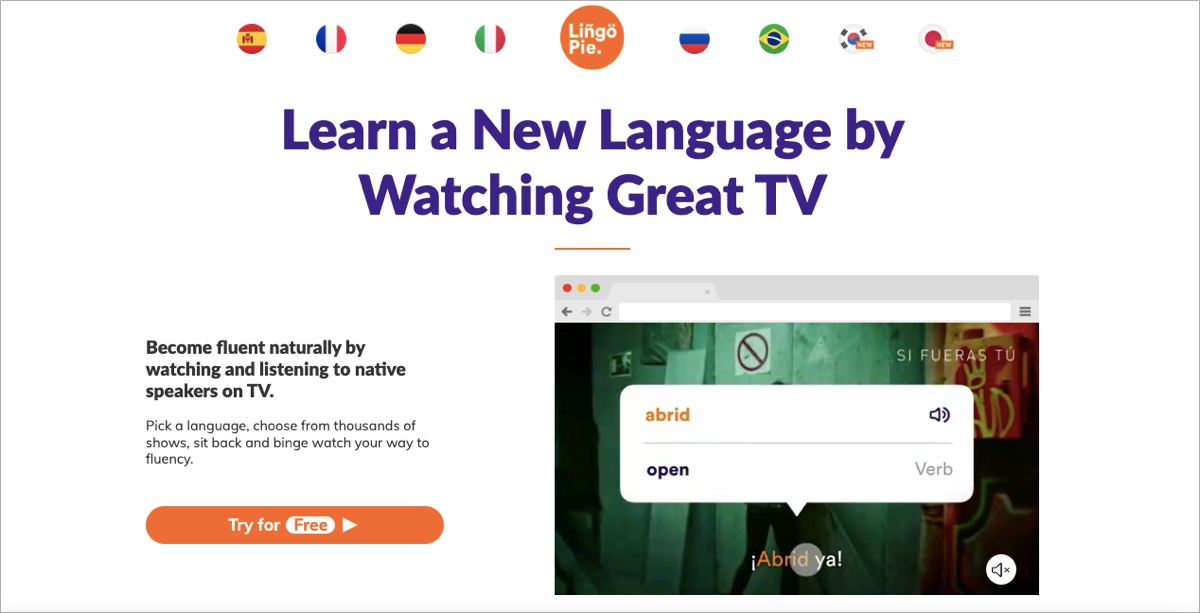
2. Street Legend
The second example showcases the Facebook carousel ad leveraged by Street Legend. It’s the right ad format for e-commerce, allowing companies to show potential customers their products. This ad includes a short copy, high-quality product pictures, and CTA buttons with a special offer, inviting users to visit the e-store and purchase products. Street Legend decided on this pay-per-click marketing strategy to show more products with a single ad, minimizing PPC efforts. As they target specific audiences based on their interests and demographics, the ad displays exactly for their target groups, increasing conversions. It’s also a great way to build brand awareness by showcasing attractive, unforgettable product visuals.
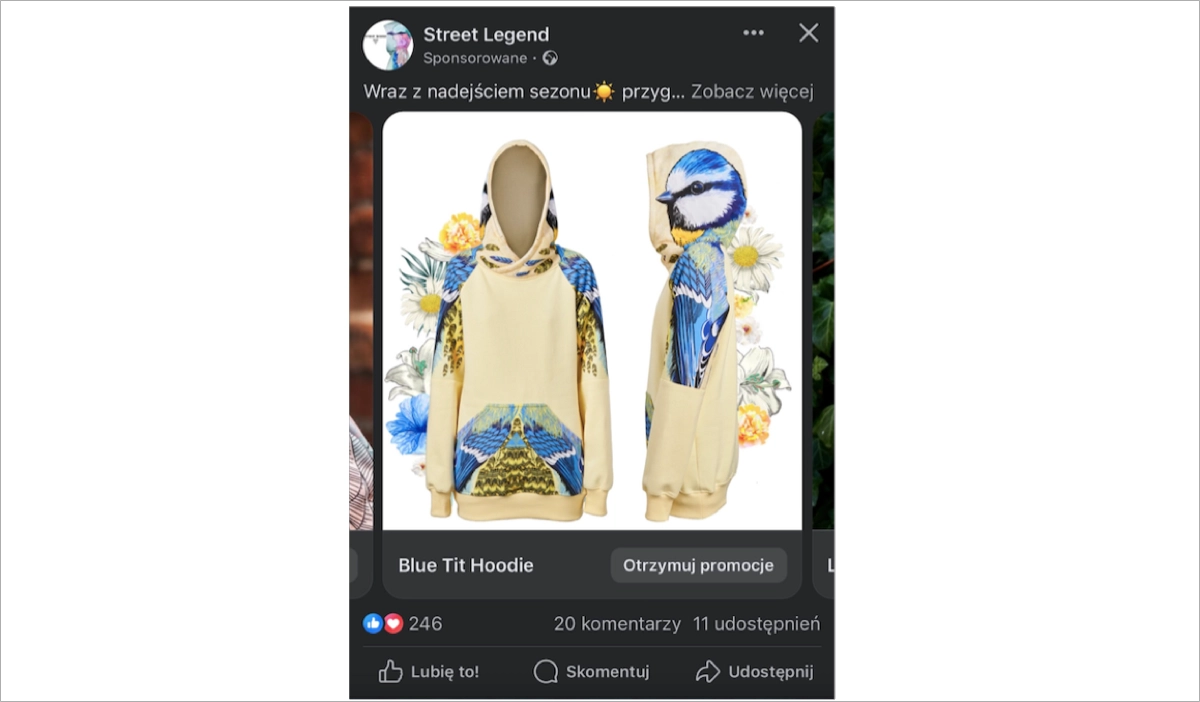
Facebook carousel ads allow advertisers to showcase multiple images or videos within a single ad unit, each with its own link. Users can swipe or click through the cards, making it an interactive experience. This format highlights different products, features, or stories within one ad. Each card can include its own headline, description, and call-to-action, offering versatile storytelling and increased engagement opportunities, which can drive higher click-through rates and conversions.
3. Goodiebox
The third example is another Facebook ad format displayed in Facebook Stories. Goodiebox presents special offers through a short story with a static picture. This ad includes a compelling headline and a clear, attractive offer – 50% off. The high-quality image showcases the products included in the special offer, making it even more attractive for their target audience. The most important element of this type of ad is a CTA button leading to a related landing page.

Facebook stories allow companies to increase brand awareness by leaving a strong visual image in users’ minds. Even if not everyone clicks on an ad, its appeal makes it helpful for overall brand building. The linked landing page is consistent with the ad, showcasing more offer details and encouraging visitors to try out their products and sign in for a box subscription.
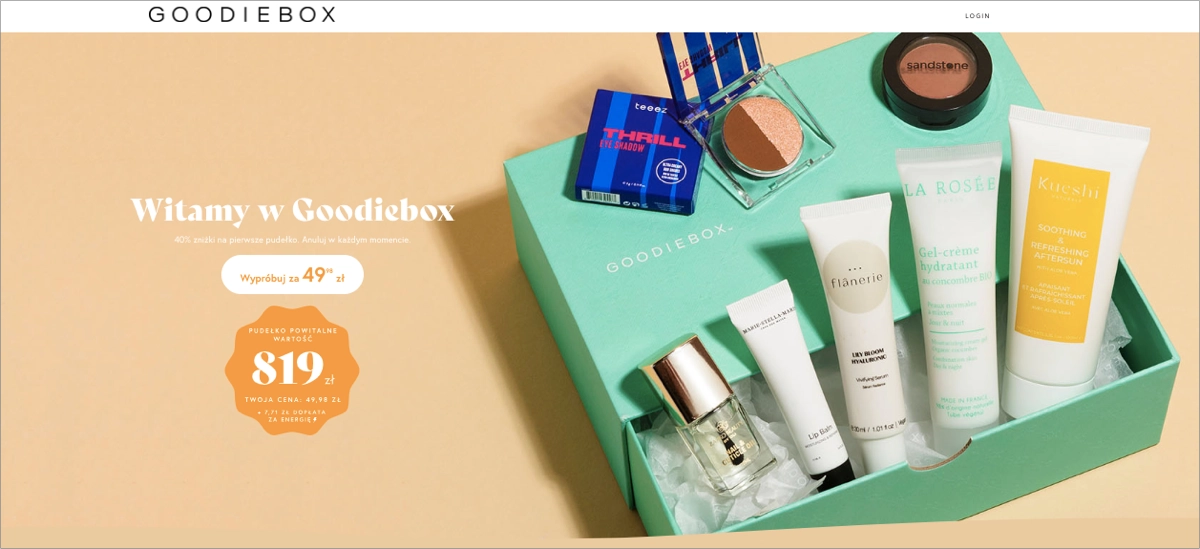
Can PPC Be Used in Social Media?
Yes, PPC can be effectively used for social media ads, as popular social media sites, such as Facebook, offer PPC advertising models that allow companies to target specific audiences. Social media use PPC to charge advertisers only when users click on their ads, making it cost-effective to drive traffic, generate leads, and boost sales.
Most social media advertising solutions utilize PPC pricing models, including CPC and CPM. YouTube uses PPC for video ads, where advertisers pay per view. Pinterest supports PPC through promoted pins, which appear in users’ feeds and search results based on targeted keywords and interests. LinkedIn provides options like sponsored content, text ads, and InMail ads, which are also billed per click or impression.
PPC in social media is one of the most effective advertisement methods. It allows for precise targeting based on demographics, interests, behaviors, and location, enhancing the efficiency of ad campaigns. Additionally, social media platforms offer robust analytics tools to measure ad performance, providing insights that help optimize campaigns for better results. This combination of targeted reach and measurable outcomes makes PPC a valuable strategy for businesses looking to maximize their social media marketing efforts.
What Is PPC on Facebook?
PPC on Facebook, known as Facebook Ads, enables advertisers to pay only for clicks or impressions. This model encompasses a variety of ad formats, including image ads, video ads, carousel ads, and story ads, each crafted to capture user engagement on the platform. Social ads can precisely target audiences based on demographics, interests, and behaviors, enhancing their effectiveness as a marketing tool. The cost-per-click (CPC) and cost-per-impressions (CPI) change depending on factors such as competition and ad relevance. It offers businesses flexible budget options to achieve their marketing objectives.
What Is the Difference Between Social Media Ads and PPC?
Social media ads and PPC both aim to drive traffic and engagement, but they operate differently. Social media ads refer to paid content promoted on platforms like Facebook, Instagram, or LinkedIn. These ads can be priced based on various models, including CPC, cost per impression (CPI, CPM), and cost per engagement (CPE). Social media paid advertising leverages detailed targeting options based on user demographics, interests, and behaviors, providing extensive reach and brand visibility.
PPC advertising solutions is a broader term encompassing any online advertising where advertisers pay when their ad is clicked. This includes search engine results ads launched on platforms like Google Ads and Bing Ads, as well as ads on social media. While PPC strictly involves paying per click, social media ads offer multiple pricing models, making them versatile in targeting and engagement strategies. In essence, all PPC campaigns can be part of social media ads, but not all social media ads are PPC.
What Is the Best PPC Social Media Tool for Landing Pages?
The best PPC social media tool for landing pages is Landingi – a multifunctional digital marketing platform that streamlines building, testing, and optimizing landing pages for marketing purposes, including PPC and social media ads.
As a great PPC software for crafting high-converting landing pages, Landingi offers professional features, including pre-designed templates, allowing users to build pages quickly and efficiently, an AI landing page builder with a content generator that allows also for SEO optimization, and a form builder, which allows crafting and optimizing forms for maximum conversion. Landingi is perfect for social media PPC, as each page crafted in its builder is automatically optimized for mobile devices. You can customize the mobile view, but automation does the hard work for you, changing dimensions and adjusting the layout of your landing page for social media advertising purposes.
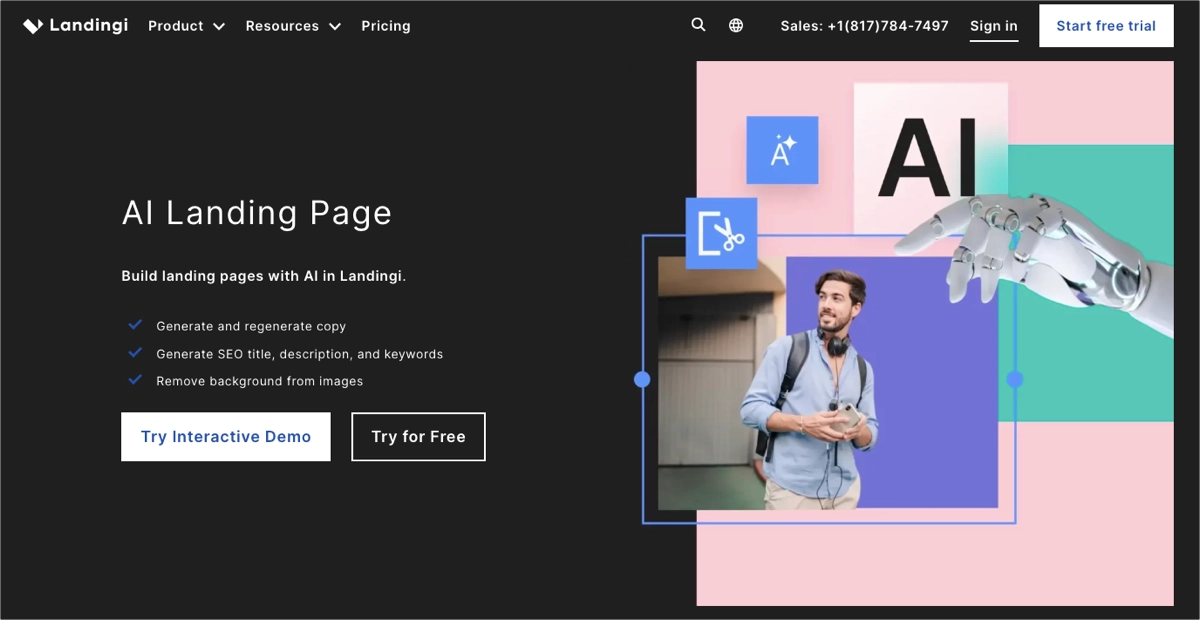
The platform also provides A/B testing features, thanks to which you can easily experiment with various landing page versions to find the most effective one. With the EventTracker solution, you can track user behavior and gather landing page performance data, which is important for further optimization. Over 170 integrations allow you to leverage Landingi as a component of your digital marketing toolkit, making it the best choice for running social media campaigns.
Landingi’s combination of ease of use and powerful customization options makes it particularly effective for PPC social media campaigns. The intuitive drag-and-drop builder simplifies the creation process, making it accessible even for those without technical skills. At the same time, the advanced customization capabilities ensure that more experienced users can create sophisticated and highly tailored landing pages. This flexibility allows businesses to craft visually stunning, responsive designs that mirror their brand’s unique style, thus maximizing engagement and conversion rates.
Create a Great Social Media PPC Campaign with Landingi
In the rapidly evolving digital marketing landscape, PPC social media advertising has emerged as an indispensable tool for businesses seeking to maximize their reach and ROI. By understanding the core principles of PPC and implementing best practices, companies can effectively target their audience, optimize their campaigns, and achieve their marketing objectives.
The most important aspects of social media advertising are setting clear goals, knowing your audience, and using compelling visuals and ad copy to engage users. Monitoring performance and making data-driven adjustments are critical to maintaining and enhancing the effectiveness of PPC campaigns. Examples showcased in this article highlight the impact of strategic targeting, creative content, and timely promotions in driving user engagement and conversions. Still, even the most immersive ads wouldn’t be efficient without well-designed landing pages.
Try Landingi now – create high-converting landing pages related to your ads and see how an optimized page can significantly boost the overall success of your PPC efforts.

